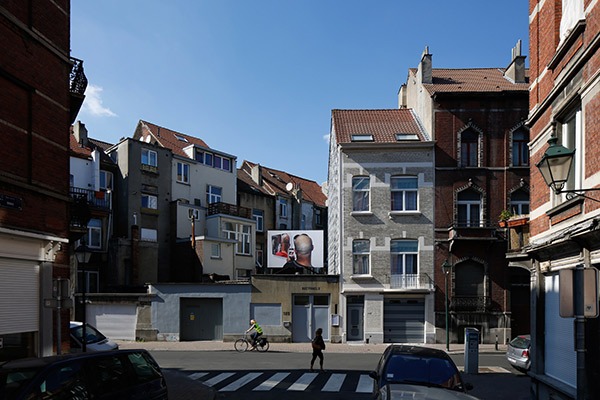Opening Wednesday 10 September 2014, 6-9pm
11 September – 10 November 2014
Rectangle, Brussels
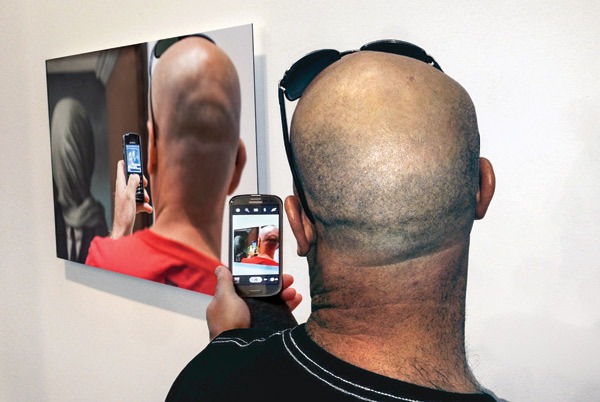
NICHOLAS KNIGHT, exhibition view No Such Thing As Subject or, Who Let the Nerds Out?
Exhibition view, Rectangle, Brussels
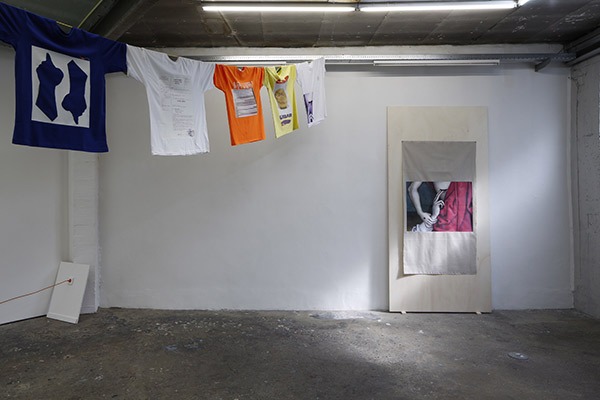
Exhibition view, Rectangle, Brussels
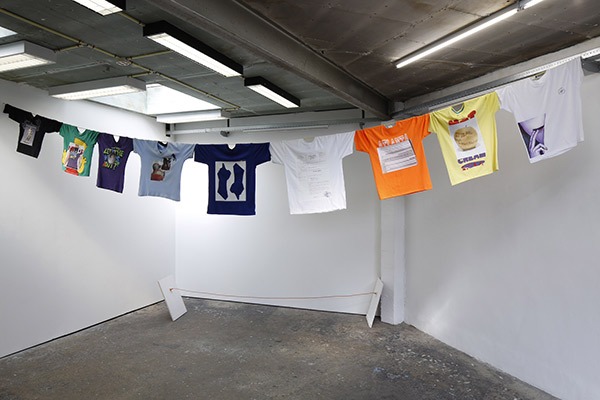
Exhibition view, Rectangle, Brussels
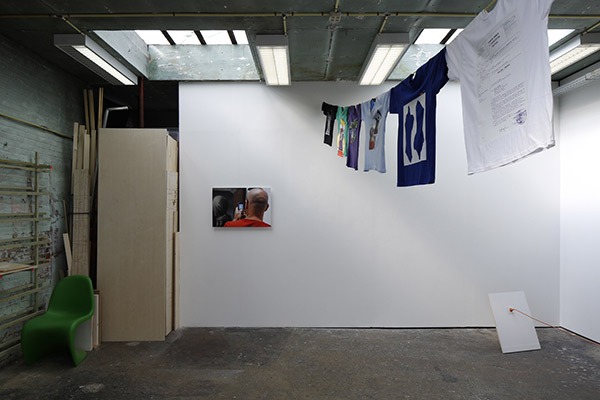
Exhibition view, Rectangle, Brussels
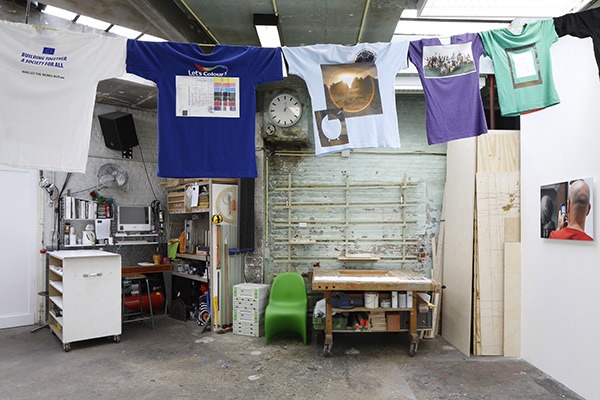
Exhibition view, Rectangle, Brussels
Nicholas Knight
Born 1975 in the United States. Lives and works in New York.
BILLBOARD STATEMENT
Taking (Taking Pictures) Pictures: Les Amants, 2014
ENGLISH
When I began photographing the camera screens of museum visitors in 2007, I thought it was a critique of the ease and mobility of that new practice of digital photography. But the more I worked on the project, the more I understood it as a way for the art viewer to make a claim on the meaning of the works they were photographing. The gesture was producing a new way to read the original. My photographs, collectively titled Taking Pictures, compress the official histories of museum artworks together with speculative narratives about these viewers.
Taking Pictures (Les Amants) was taken at the Museum of Modern Art in New York, showing a classic painting by Magritte. A print was shown at La Panacée, in Montpellier, France, in February 2014. The art center invited their visitors to re-photograph my work in the same style, and they collected an excellent group of these images. For the Rectangle billboard, I chose a photograph sent in by M. Douarche, who took great care in recreating the condition of my original picture. I have now taken some care to reclaim his gesture as my own artwork again. It’s clear that there is no escape from this process – the snake continually swallows its own tail. Or is it the tail that swallows the snake?
Nicholas Knight
FRANÇAIS
Quand j’ai commencé à photographier les écrans d’appareil photo des visiteurs de musée en 2007, je pensais critiquer le confort et la mobilité des nouvelles pratiques de la photographie numérique. Mais plus je travaillais sur ce projet, plus je comprenais qu’il s’agissait d’un moyen pour le regardeur de s’interroger sur le sens des oeuvres qu’il photographiait. Ce geste produisait un nouveau moyen de lire l’original. Mes photographies, intitulées collectivement Taking Pictures, réunissent l’histoire officielle des oeuvres de musée et les narrations spéculées par ces visiteurs.
Taking Pictures (Les Amants), prise au Musée d’Art Moderne de New York, montre une oeuvre classique de Magritte. Elle fut montrée à La Panacée, à Montpellier, France, en février 2014. Le centre d’Art invitait les visiteurs à re-photographier mon travail de la même manière, et réunit un excellent échantillon de ces images. Pour le panneau de Rectangle, j’ai choisi une photographie envoyée par M. Douarche, qui reproduit avec soin les conditions de l’image originale. À mon tour, j’ai pris soin de revendiquer son geste comme mon oeuvre. Il n’y a pas d’échappatoire à ce processus – le serpent se mort continuellement la queue, à moins que ce ne soit la queue qui avale le serpent?
Nicholas Knight
NEDERLANDS
Toen ik begon met het fotograferen van museumbezoekers op de schermen van bewakingscamera’s in 2007, dacht ik dat het een kritiek was op het gemak en de mobiliteit van die nieuwe praktijk, de digitale fotografie. Maar hoe meer ik werkte aan het project, hoe meer ik het begreep als een manier van de kunstkijker om betekenis te claimen van de werken die ze fotografeerden. Het gebaar produceerde een nieuwe manier om het origineel te lezen. Mijn foto’s, samen getiteld als Taking Pictures, brengen de officiële geschiedenis van museumkunstwerken samen met speculatieve verhalen van hun toeschouwers.
Taking Pictures (Les Amants) werd genomen in het Museum of Modern Art in New York, en toont een klassieke schilderij van Magritte. Een afbeelding was te zien in La Panacee, in Montpellier, Frankrijk, in februari 2014. Het kunstcentrum nodigde hun bezoekers uit om opnieuw een foto van mijn werk te maken in dezelfde stijl, en ze verzamelde een uitstekende set van deze beelden. Voor het Rectangle paneel koos ik een foto ingezonden door M. Douarche, die met veel zorg de conditie herschiep van mijn originele foto. Ik heb nu, ook met veel zorg, zijn gebaar opnieuw geclaimd als mijn eigen kunstwerk. Het is duidelijk dat er geen ontsnappen is aan dit proces – de slang bijt voortdurend in zijn eigen staart. Of is het de staart die de slang inslikt?
Nicholas Knight
EXHIBITION STATEMENT
NICHOLAS KNIGHT
No Such Thing As Subject or, Who Let The Nerds Out?
Opening Wednesday 10 September 2014, 6-9pm
11 September – 10 November 2014
Rectangle, Brussels
ENGLISH
I got into a friendly argument recently, about whether all language was equal or if some kinds were better than others. My position was, yes, some are better. “Better”, for me, is not a matter of precise grammar, or eloquence, or propriety, or “truth”. Better language is delivered – and received – in good faith. The “good faith” test is problematic, of course. How is it measured and verified? I don’t really know that answer, but in part, I would say that with good faith, we have permission to understand. And misunderstand!
In its original form, Intension: Tethered (2007) depicts the wall and outlet in the actual gallery, and the cord connects the picture back to the source. I remade this piece in 2014 at La Panacée in Montpellier, France, and after that exhibition, they cut out the section of wall shown in the photograph so that it could stay with its own image. Now at Rectangle, the photo and the wall section are freestanding, tethered to each other but not the original site.
That work was an attempt to fix the photograph in place, to prevent it escaping its origin so easily. When I began Taking Pictures in 2007, I thought it was a critique of the ease and mobility of that new practice of digital photography. But the more I worked on the project, the more I understood it as a way for the art viewer to make a claim on the meaning of the works they were photographing. The gesture was producing a new way to read the original. My photographs compress the official histories of museum artworks together with speculative narratives about these viewers. A new, limited-edition publication documents this work and the history of its rapidly shifting technology.
Taking Pictures (Les Amants) was also shown at La Panacée. The art center invited their visitors to re-photograph my work in the same style, and they collected an excellent group of these images. For the Rectangle billboard, I chose a photograph sent in by M. Douarche, who took great care in recreating the condition of my original picture. I have now taken some care to reclaim his gesture as my own artwork. It seems there is no escape from this process, as the snake continually swallows its own tail. Or is it the tail that swallows the snake?
Entanglement begins with the question, “Why do we take all these pictures?” I love taking snapshots! But as they pile up on the hard drive, what is their use? What story holds them all together? They slip so easily into generality. This project begins by going to a second-hand store in town (Brussels in this case) and buying some old t-shirts. These used clothes have a history but it has been abandoned. We can only guess about it, and that fragment becomes the surface that supports my own untethered picture. Multiple narratives are bound together, and hopefully produce their own new thing.
Maybe I haven’t made much progress in this statement towards clarifying “good faith”. Even so, I want these works to open a space that is not fully determined by intention, a space that is then also an invitation.
Nicholas Knight
FRANCAIS
J’ai récemment débattu avec un ami de la question suivante: tous les langages sont-ils égaux ou certains sont ils meilleurs que d’autres? Ma position était, oui, certains sont meilleurs. “Meilleurs”, pour moi, n’est pas une question de grammaire, ou d’éloquence, ou de correction, ou de “vérité”. Un meilleur langage est délivré – et reçu – de bonne foi. Tester la “bonne foi” est bien sûr problématique. Comment la mesurer et la vérifier? Je n’ai pas la réponse à cette question, mais pour tenter d’y répondre, je dirais que de bonne foi, nous nous autorisons à comprendre. Et à mal comprendre!
Dans sa forme originale, Intension: Tethered (2007) montre l’image d’une prise électrique murale sur laquelle est branché un câble d’alimentation, connecté à l’autre bout à la source de courant photographiée. J’ai refait cette pièce en 2014 à la Panacée à Montpellier, France. Après l’exposition, la portion de mur photographiée a été découpée pour lui permettre de rester avec sa propre image. Désormais à Rectangle, la photo et le morceau de mur tiennent en équilibre, attachés (en anglais ‘tethered’) l’un à l’autre, mais séparés du site original.
Cette pièce était une tentative de maintenir la photographie sur place, de l’empêcher de s’échapper de son origine si facilement. Quand j’ai commencé Taking Pictures en 2007, je pensais critiquer le confort et la mobilité des nouvelles pratiques de la photographie numérique. Mais plus je travaillais sur ce projet, plus je comprenais qu’il s’agissait d’un moyen pour le regardeur de s’interroger sur le sens des oeuvres qu’il photographiait. Ce geste produisait un nouveau moyen de lire l’original. Mes photographies réunissent l’histoire officielle des oeuvres de musée et les narrations spéculées par ces visiteurs. Une nouvelle publication en édition limitée documente ce travail et l’histoire de la rapide évolution de sa technologie.
Taking Pictures (Les Amants) était aussi montré à La Panacée. Le centre d’Art invitait les visiteurs à re-photographier mon travail de la même manière, et réunit un excellent échantillon de ces images. Pour le panneau de Rectangle, j’ai choisi une photographie envoyée par M. Douarche, qui reproduit avec soin les conditions de l’image originale. À mon tour, j’ai pris soin de revendiquer son geste comme mon oeuvre. Il n’y a pas d’échappatoire à ce processus – le serpent se mort continuellement la queue, à moins que ce ne soit la queue qui avale le serpent?
Entanglement commence avec la question: “pourquoi prenons-nous toutes ces images?” J’adore prendre des photos! Mais une fois stockées sur le disque dur, quel devient leur usage? Quelle histoire les réunit? Elles glissent si facilement dans le général. Ce projet commence par une virée dans une friperie du centre-ville (Bruxelles ici) pour y acheter quelques vieux t-shirts. Des vêtements utilisés, mais dont l’histoire a été abandonnée. Une histoire qu’on ne peut que tenter d’imaginer. Ce fragment devient le support de mes propres images détachées, autonomes (en anglais “untethered”). Plusieurs narrations se retrouvent liées entre elles, et produisent je l’espère leur propre histoire.
Peut être n’ai-je pas beaucoup avancé dans la clarification de mon statement sur la “bonne foi”. Quand bien même, je veux que ces pièces ouvrent un espace qui ne soit pas entièrement déterminé par intention, un espace qui soit aussi une invitation.
Nicholas Knight
